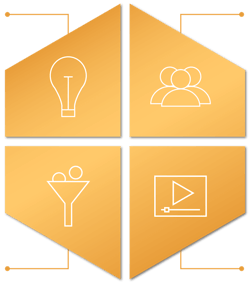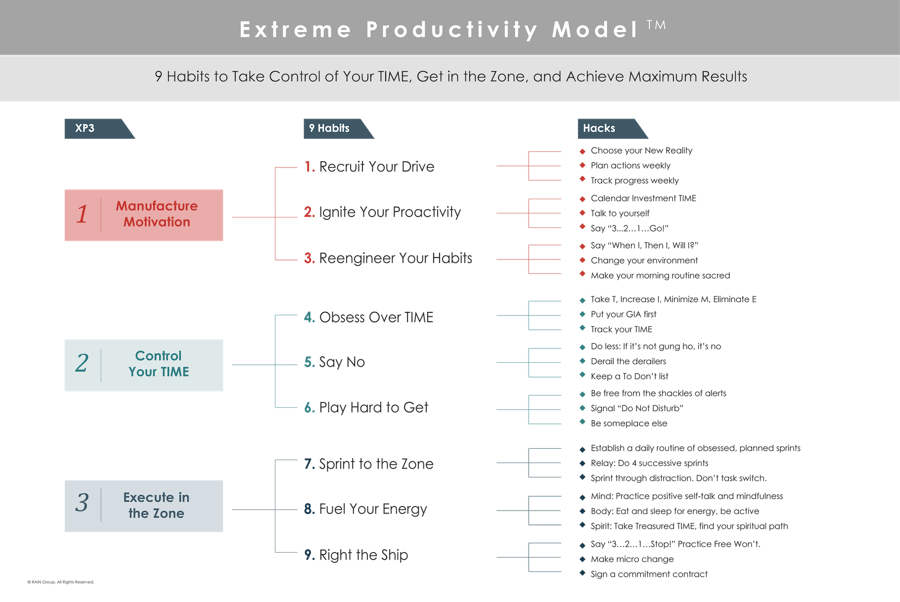During a now-famous interview on the Pierre Berton Show in 1971, Bruce Lee shared a simple philosophy: “be like water.” As fitting as Lee’s advice is for sellers, “be like a sponge” works just as well.
To stay ahead, sales teams must continuously absorb new information and develop skills. Ongoing training and coaching and sustained effort over time is crucial. Otherwise, sellers (and their managers) risk not reaching their potential. Fortunately, there are sales training techniques that even the most experienced teams will soak up.
Why Is Sales Training So Important?
Without strong sales training methods in place, sellers are less likely to become Top Performers. Our Top-Performing Sales Manager Research shows that sales training is a linchpin of top-performing teams. When sellers have a mix of effective training, regular coaching rhythm, and effective management, they’re 63% more likely to be Top Performers.
Impact of Manager + Coaching + Sales Training on Seller Performance
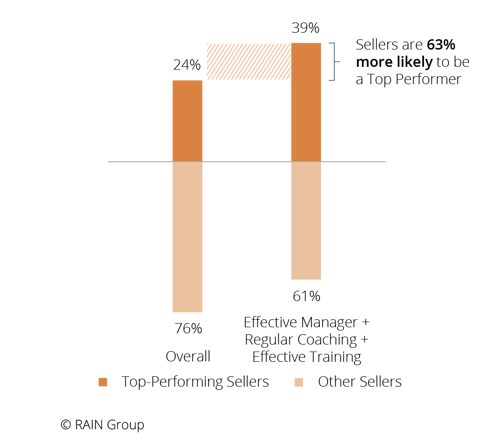
Sales Training Techniques to Boost Your Sales Performance
To help you train sellers more effectively, we’ve sourced a list of our 14 best sales training techniques. We encourage you to integrate these methods into your own programs, whether in-house or executed by a third-party sales training provider.
1. Take the Long View
In the spirit of gaining an edge, or jump-starting performance altogether, there’s a tendency to view sales training as a quick fix. This might also be why so much sales training falls short. The truth is that sales training shouldn’t be treated as a one-time circumstance, but an ongoing process.
This doesn’t mean bombarding your team with a new initiative every day. In our experience, the best sales training is built on a framework for not only crafting strategy and delivering training, but enabling sellers to sustain success after training is complete.
Execution Assurance Framework
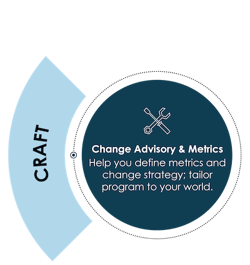 |
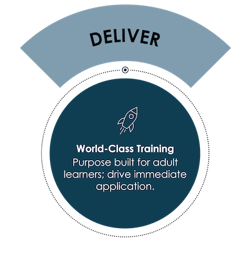 |
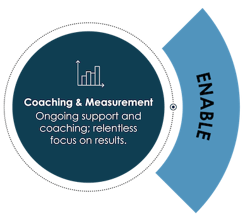 |
Too often, training delivery gets all the attention while coaching and measurement are neglected. Those who take the long view and provide ongoing support and coaching are more likely to achieve desired results.
2. Deliver Focused Blocks of Training Modules
In sales, it’s especially important to deliver focused and relevant training.
Why? First, not all sales teams are at the same level, nor do they have the same skill development needs. Second, if sellers and their managers are taking time away from selling to attend training, they demand the time be well spent.
Too many theoretical lectures without practical application. Unfocused and irrelevant content that doesn’t translate into their specific selling situation. Examples they can’t relate to. No compelling case for why they should change the way they’ve always done things.
There’s a reason that between 85% and 90% of sales training has no lasting impact after 120 days.
Instead, deliver modular blocks of learning that are tailored for your team and allow you to match the curriculum, content, and cohorts. Optimize each block to maximize learning outcomes in a specific area. As needed, blocks can be moved around, grouped, and ordered to suit each team’s learning needs.
Modular Learning Design
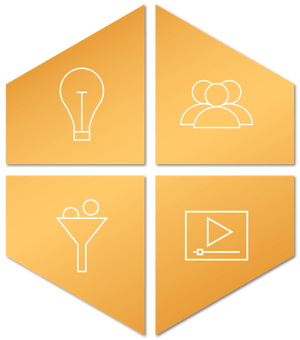
1. Learn
Pre-work is delivered via micro learning, video, and exercises that allow participants to learn key concepts prior to classroom sessions.
2. Collaborate & Practice
Highly interactive and collaborative classroom sessions, delivered virtually or in person, focus on practice, application, and feedback.
3. Reinforce & Apply
Micro learning and videos drive post-session reinforcement. Application Assignments allow sellers to apply new skills to live sales situations.
4. Refine
Between sessions, Application Coaching helps sellers refine skills and build confidence while being held accountable for on-the-job implementation.
3. Use Live and Online Blended Learning Techniques
In many cases, in-person sales training remains quite effective. But virtual instructor-led led training has gained substantial traction in recent years. Indeed, some research shows that 80% of L&D leaders believe virtual training produces better outcomes.
In our experience, delivering modular blocks of learning (see #2 above) that use a blend of modalities—whether the instructor-led training sessions are live onsite or virtual—creates an opportunity to truly engage sellers with the training, change behaviors, and achieve results.
This includes:
- Self-directed digital learning modules, video, and exercises
- Collaborative classroom sessions delivered virtually or in person
- Interactive digital reinforcement, such as micro learning and videos
- Application assignments that allow sellers to apply new skills to live sales situations
- Application coaching that helps sellers practice skills and implement on-the-job
Such blended training approaches are especially useful for geographically dispersed sales teams that need to make the most of their training time.
4. Create Engaging Application Assignments
It’s one thing to learn new sales skills, it’s yet another to reinforce and apply them in practice. Application assignments give learners the opportunity to distill what they’ve learned and apply it to live sales situations.
Examples include situational role-playing between a sales rep and their coach; or a practice demo in front of a live audience. Beyond driving post-training reinforcement, these application assignments give coaches the opportunity to assess learning and provide feedback.
5. Customize Case Studies, Examples, Tools, Playbooks, and Job Aids
Sellers can smell generic sales training techniques from a mile away. Make it real by customizing relevant elements of the training program from the examples you share to the tools and job aids you deploy. For instance, with the help of our team, Agilysys customized their training program and doubled their win rate.
A few of the customizations include:
- Tailor content in training workshops for target industries
- Build customized versions of training assets (e.g., Sales Opportunity Planner)
- Reinforce training through live webinars, scenario emails, and online sales training
6. Offer Flexible and Consistent Reinforcement
By some accounts, only 44% of organizations reinforce their sales training with some form of follow up. In these once-and-done training environments, the burden falls squarely on sellers to make sure their training sticks.
Instead, take a proactive approach. Have sales managers, coaches, and the sales enablement team play an active role to reinforce sales training. In Sales Training Reinforcement: How to Get it Right, we share nine ways organizations can reinforce sales training by offering:
- Virtual instructor-led training and webinars
- Online training and lessons
- Ongoing live workshops
- Mobile and email reinforcement
- Job aids and tools
- Simulations and gaming
- Regular role playing
- Embedding technology
- Sales coaching
Whichever reinforcement techniques you use, flexibility is important. Just as people learn new skills and techniques in different ways, so too do they master them. The point is to make different options available so that sellers can find the reinforcement methods that work best for them (and their schedule).
7. Incorporate Testing and Certification
There are sales training techniques and then there are the sales trainers who deliver them. One way to improve the effectiveness of sales training is to train and certify in-house sales trainers and facilitators. For example, our Train the Trainer program certifies in-house trainers in all of our proprietary sales training methods.
Testing and certification create an opportunity for facilitators to learn best practices around delivering training, become familiar with the content, and work one-on-one with experienced facilitators. For example, at RAIN Group, we certify facilitators based on proficiency in four areas:
- Outcomes
- Preparation
- Delivery Approach
- Management
Train the Trainer Design
1. Setup and Kickoff
Set the table for success with self-study learning lessons, video walkthroughs, best practices, run sheets, facilitator notes, and more.
2. Study and Prepare
Trainers study learning modules, past deliveries, videos, and other resources, working with a master facilitator to prepare for their own delivery.
3. Observe and Certify
Trainers deliver an internal session reviewed, scored, and debriefed by a master facilitator. When successful, certification is awarded.
4. Support and Elevate
Trainers receive facilitation coaching, including advisory before and review after sessions; ongoing partnership to improve quality over time.
8. Enhance Personal Productivity
Improving skills is just part of the sales training process. Execution is arguably just as important, which is where productivity comes in.
The extent to which a salesperson can manufacture motivation, control available time, and maximize their most productive flows can translate directly to sales performance.
Indeed, our research shows top-performing sellers are significantly more likely to be highly rated across all 9 major productivity areas analyzed:
- Recruit drive
- Ignite proactivity
- Re-engineer habits
- Obsess over time
- Say no
- Play hard to get
- Sprint into the zone
- Fuel energy
- Right the ship
Not surprisingly, strong productivity behaviors must be cultivated. Yet few training programs proactively include such sessions in their training. Those that do are more likely to develop sellers who execute on what they’ve learned during their sales training and see results.
9. Give Sellers Ownership
For all the planning and management involved in sales training, sellers need to take ownership of their own success. Until they do, they'll never reach their potential. The best sales leaders recognize this, and they work to get sellers to accept and maximize their sense of ownership.
For example, when sellers begin working with a RAIN Sales Coach, they're given the option to accept the 90-Day Extreme Productivity Challenge. The purpose of this challenge is to allow the seller to test the limits of his or her potential.
Why make it optional?
You can't force anyone to do something like this. The person needs to want it. He or she needs to elect it. Not everyone does.
However, those who do—the sellers who have the strong desire and commitment for achievement and who take responsibility for their own success—often accept the training, coaching, challenges, and extra support you're willing to give them. When they do, they typically surprise even themselves with what they can achieve.
10. Build a Goal and Action Plan
A salesperson’s day-to-day experience revolves almost entirely around goals and actions. They know they have a quota to hit, for example. Or a net-new business target they’ve been challenged to meet. What actions do they need to take to do so?
Building a plan—setting goals and identifying the actions needed to achieve them—is a way for sellers to hold themselves accountable and improve their chances of success. Have your sellers complete our 5-step goal-setting worksheet:
- Set goals
- Plan actions
- Identify how to change habits
- Control your time
- Set boundaries and avoid distractions
Getting training in a specific skill set or capability will often be among the actions sellers need to take to reach a goal. Say, for example, a seller is looking to increase their pipeline by 25%. Developing their sales prospecting skills may be one of the actions to get them there.
Great sales leaders, managers, and coaches guide sellers through a goal-setting process, but don't specifically define their goals for them. This is not only important to help the seller take ownership, it also affects their desire to achieve.
This isn't to say sales managers and leadership shouldn't give sellers targets and quotas—they should. Sellers, however, need to take responsibility for reaching those targets and they should have other goals they're working towards achieving as well (e.g. earning a promotion, saving more in retirement, etc.). When managers help sellers connect goals to action, sellers are more motivated to achieve.
Using a goal and action plan not only helps sellers achieve goals, but also increases sellers' commitment to engage and follow through on training they receive when applied at the organizational level.
11. Encourage Accountability Partners
Sometimes achieving sales goals means being accountable to someone other than ourselves. Just by checking in with someone each week, a seller can increase the likelihood they’ll achieve their goals. This is why we encourage sales teams to make accountability partners part of their training programs.
Accountability partners are one of the most underrated sales training techniques. But the underlying process is pretty simple:
- Find an accountability partner on the team
- Write out your priorities
- Share those priorities with your accountability partner
- Check-in on your progress with your accountability partner on a weekly basis
12. Train Your Sales Managers
We allot considerable time and resources toward training sellers. But it’s a mistake not to extend training to sales managers, too. The data shows that a sales manager’s training correlates to their team’s performance. Top-Performing Sales Managers are 46% more likely to receive extremely or very effective sales training compared to other managers.
A well-trained sales manager will instill confidence in their team and help boost their team’s performance. For example, they’ll:
- Be prepared to lead valuable one-on-one coaching meetings
- Know how to motivate sellers to be highly productive
- Help sellers solve problems and challenges
- Coach sellers to lead masterful sales conservations
Download the Infographic: 10 Key Roles of the Best Sales Managers
13. Deliver a Regular Coaching Schedule
Make a quick survey of any sales training best practices list and you’ll find more than a few references to coaching, and for good reason. Even the best sellers benefit from coaching: 59% of Top Performers receive a regular ongoing schedule of coaching.
In our Top Performing Sales Organization research, we found that Top Performers are much more likely to prioritize the time sales managers spend coaching. In fact, only 28% of The Rest (representing 80% of respondents) agreed their organization prioritizes coaching. And when sales coaching is provided, it's often infrequent, ad hoc, and sporadic.
In and of itself, this isn't bad. Ad hoc coaching on winning specific opportunities can be great, but unless there's a specific and regular rhythm of conversation and connection between coach and seller, motivation can be hampered and uneven. Setting a specific coaching schedule improves accountability and ensures that learning is sustained and reinforced.
Here are examples of types of coaching that can happen on a regular rhythm of sessions:
- Deal coaching
- Skill and development coaching
- Solving problems and challenges
- Action planning
- Accountability check ins
- In-field coaching
- 1-on-1 meetings
- Strategic coaching
- Motivational coaching
14. Build a Detailed Coaching Plan
Beyond delivering regular coaching, the best sales managers and coaches create a detailed plan for developing each seller. The plan should be tailored to each seller's strengths, weaknesses, and overall goals. Broadly speaking, a sales coaching plan includes:
- What sellers should do differently
- What and how much time goes into daily, weekly, bi-weekly, monthly, and quarterly coaching sessions
- Specific action items for each objective (e.g., motivate, develop, etc.)
- Proficiency (now and target), plan to develop, and proficiency tests for each target skill, knowledge, and attribute
- Accountability partner, meeting cadence, and the goals and objectives to be discussed
Building and implementing a detailed coaching plan is a sales training technique that reinforces both in-person and virtual training and pays dividends long after the training’s been delivered.
Learn More: Building Your Sales Coaching Plan + Checklist
15. Outsource Your Sales Training
A common thread throughout most of these sales training methods is regularity. Some teams may have internal resources and facilitators at the ready to deliver training. But even high-performing sales teams will call in outside sales training professionals for additional support. The right external provider will act as an extension of your team, identifying training gaps and tailoring plans to fill them.
RAIN Group's own sales performance improvement consulting helps sales organizations uncover their greatest opportunities for growth. And our sales training programs, which incorporate the sales training techniques detailed above, are designed for sellers and sales managers.
Sales Training Is Long-Term, Not A Quick-Fix
There are no silver-bullet training techniques to plug a sales team’s shortcomings. For learning to stick and behaviors to change, it takes capable and committed leaders, training and coaching tailored to each seller, and sustained effort over time.
Be specific about goals and timelines. Build frameworks that hold people accountable. Above all, play the long game with your sales training program. And don’t forget to challenge sellers to channel their inner Bruce Lee.






